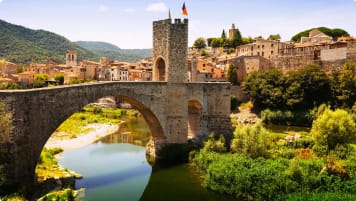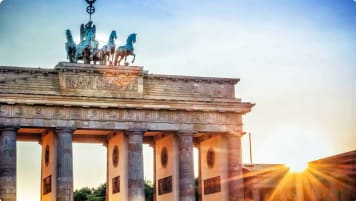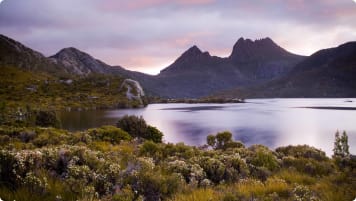Tour of Tunisia
Join Odyssey Traveller on this small group tour of Tunisia in North Africa for couples and solo travellers, where Carthaginian ruins sit side by side with Roman monuments, grand Islamic mosques, Arabic souks and medina, and honeycomb-like Berber cave dwellings and hilltop villages.
From A$11,950AUD
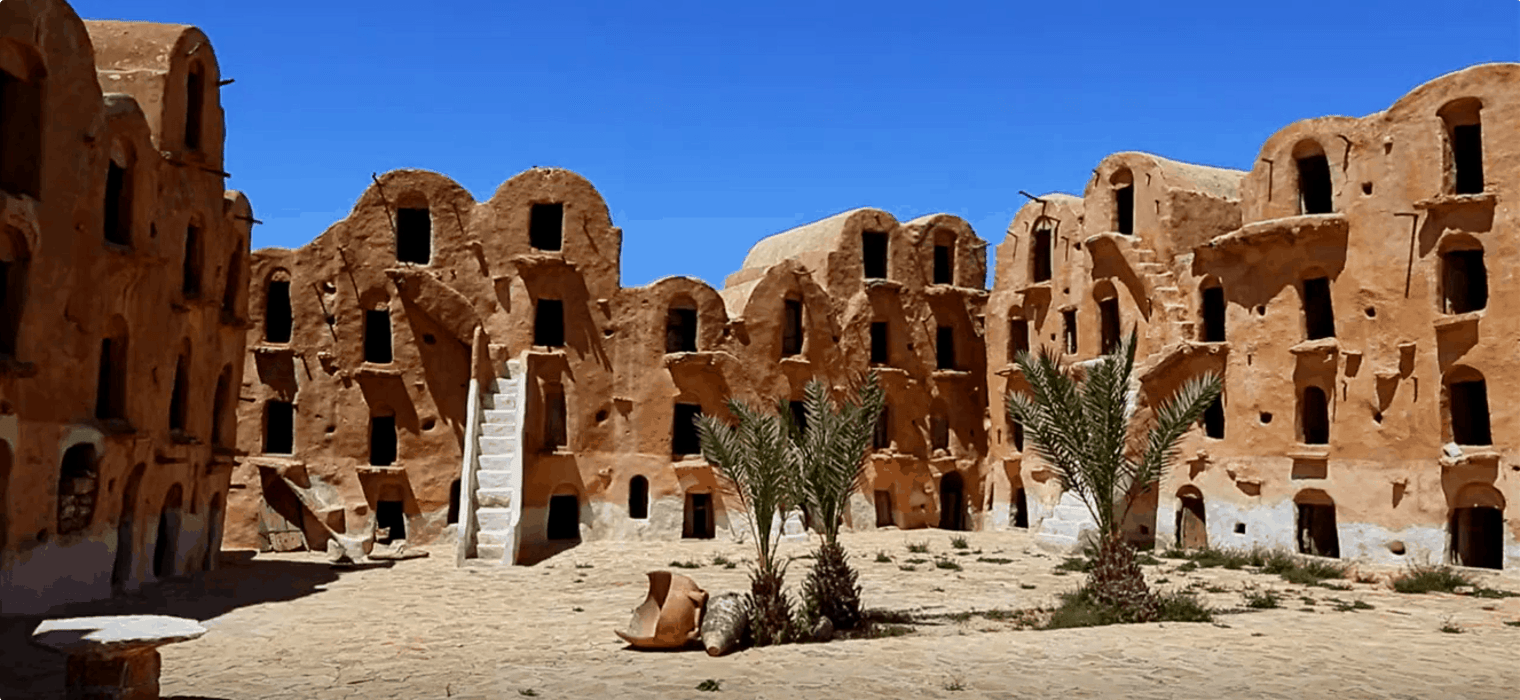
Highlights
- 1. Enter the Great Mosque of Kairouan, founded in the year 670 and the oldest Islamic place of worship in Africa.
- 2. See cliff-top Sidi Bou Said, a picturesque Andalucian-style village with white-washed buildings and blue doors and windows.
- 3. Spend time on the Isle of Djerba, the largest island of North Africa and home to Muslim, Berber and Jewish communities.
- 4. View Berber-era dwellings and granaries, many of which were used as shooting locations for the Star Wars saga.
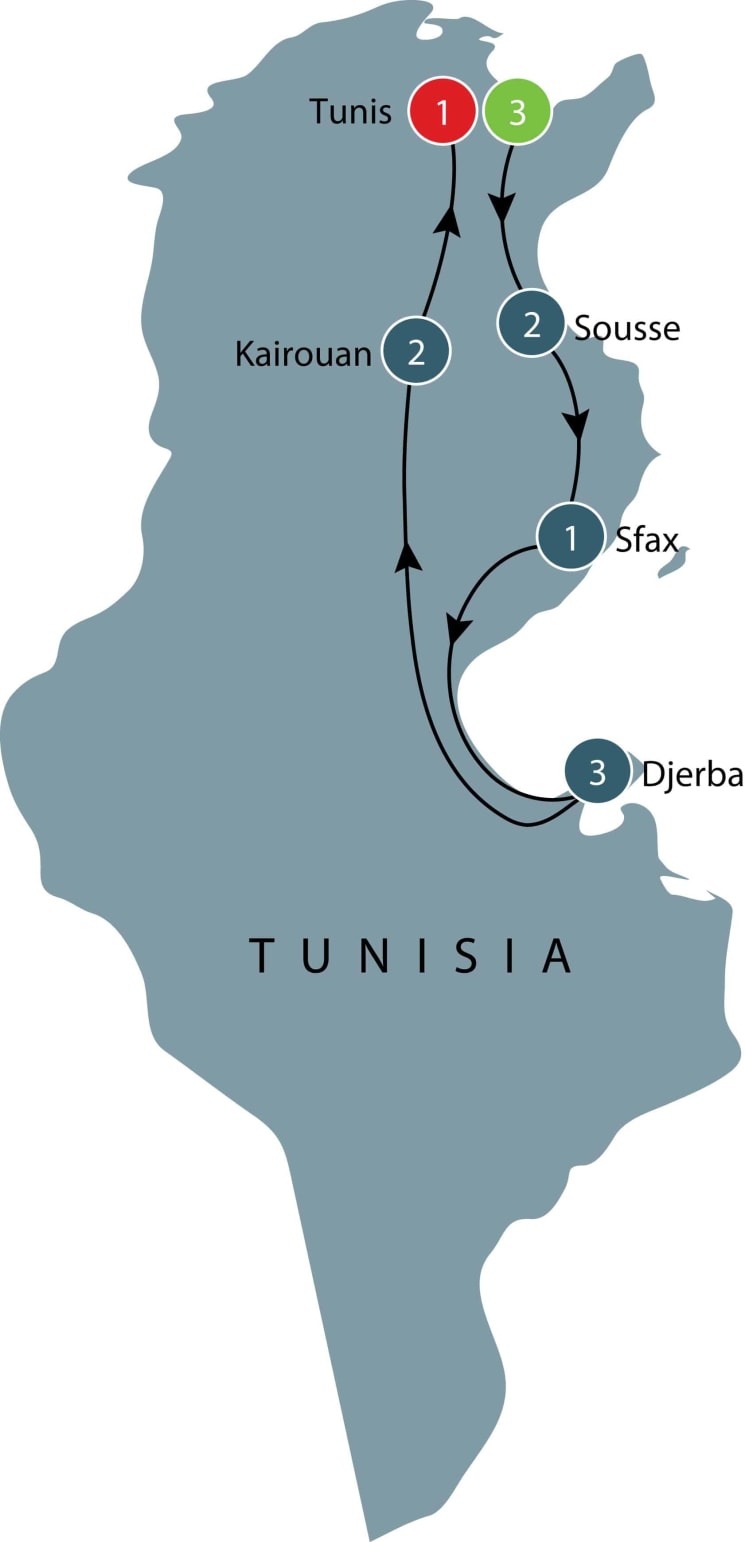
Departure Dates
| Departure Date | Price |
|---|---|
| 29 September 2025 Ends 12 October 2025 • 14 days A$11,950 Twin A$12,900 Single Available | Selected |
| 30 March 2026 Ends 12 April 2026 • 14 days A$12,450 Twin A$13,650 Single Available | |
| 28 September 2026 Ends 11 October 2026 • 14 days A$12,450 Twin A$13,650 Single Available | |
| 29 March 2027 Ends 11 April 2027 • 14 days A$12,750 Twin A$13,995 Single Available | |
| 27 September 2027 Ends 10 October 2027 • 14 days A$12,750 Twin A$13,995 Single Available |
Tour of Tunisia
Join Odyssey Traveller on this small group tour of up to 14 mature and senior travellers of Tunisia in North Africa, where Carthaginian ruins sit side by side with Roman monuments, grand Islamic mosques, Arabic souks and medina, and honeycomb-like Berber cave dwellings and hilltop villages. This tour is suitable for couples and solo travellers
Tunisia is home to the ancient city of Carthage. With its coastal access to the Mediterranean sea and inland access to the Sahara, it attracted settlements and conquerors throughout the centuries, resulting in a highly diverse culture as Jewish and Christian populations lived with a Muslim majority for many centuries. On this tour, we will learn more about the changing landscapes and the interactions of various empires, religions, and cultures in this country.
This 14-day tour begins and ends in the capital city of Tunis, the city of storytellers. We will travel north to south and north again along the Tunisian coast, visiting historic villages, archaeological sites, and hilltop towns offering relaxing vistas. We will spend multiple nights in:
- Tunis
- Sousse
- Sfax
- Djerba
- Kairouan
Brief History of Tunisia: From Ancient Carthage to Independence
Greek legend tells us that Dido, the Phoenician princess of Tyre (present-day Lebanon), settled among the native Berber (Amazigh) tribes and established the great city of Carthage on the north coast of Africa.
Legends aside, Carthage did rise around the 9th century BC following the destruction of Tyre by the forces of Alexander the Great, and indeed grow to become the most important city on the Mediterranean prior to the rise of Rome. Carthage stood in the way of Roman domination in the western Mediterranean, and the two powers fought in the Punic Wars (‘Punic’ has the same root as ‘Phoenician’), the first of which began in 264 BC. The Punic Wars ended with Carthage defeated and the city completely destroyed, and many of the Phoenician settlements became part of the Roman empire.
Rome would rule the region for the next 500 years. In the 7th century AD, the Arab conquests in North Africa converted the Berber population to Islam. After a succession of Islamic dynasties, Tunisia came under French colonial rule. This ended when Tunisia declared independence in 1956.
Tour Highlights
Carthaginian and Roman Ruins
Carthage is now a residential suburb in Tunis. The Archaeological Site of Carthage is a UNESCO World Heritage Site, and here we will see the ruins of the Punic and Roman empires, including Byrsa Hill, a walled citadel above the Phoenician harbour and said to be where Princess Dido founded the city.
We will visit Kerkouane, a Phoenician city possibly abandoned after the First Punic War and not inhabited nor rebuilt by the Romans. This left behind the ruins of a Phoenician town and necropolis untouched by later civilisations.
Tunisia has incredible Roman ruins that can rival that of Rome's. We will see the Antonine Baths, the largest built Roman baths on the African continent, the Zaghouan Aqueduct, an ancient Roman aqueduct that once supplied water to Carthage, and the El Jem Amphitheatre, the best-preserved Roman amphitheatre in Africa, designed to seat 35,000 spectators. Bulla Regia and Dougga are full Roman settlements; the latter has been described by UNESCO as "the best-preserved example of an Africo-Roman town in North Africa" and "an exceptional illustration of what daily life was like in Antiquity"--certainly a standout visit for those interested to learn more about Roman presence in the African continent.
Arabian and Islamic Monuments
We will visit Kairouan, a UNESCO World Heritage Site. Kairouan was founded by the Umayyads in the 7th century and became a centre for Sunni Islamic scholarship and an important Islamic city, next only to Mecca and Medina in Saudi Arabia. Here, we will see the Aghlabid Basins, an advanced work of engineering in the Middle Ages; the Great Mosque of Kairouan, founded in the year 670 and the oldest Islamic place of worship in Africa; and the Raqqada National Museum of Islamic Art, which holds collections of priceless medieval Islamic art and objects.
We will visit the Medina of Tunis, a UNESCO World Heritage Site, which grew around the Zitouna Mosque (Al-Zaytuna Mosque), which is the oldest in the city. It has 160 columns said to have been brought originally from the ruins of Carthage.
We will also explore the Medina of Sousse (also spelled Susa or Sousa), a former Phoenician colony that fell to the Romans, but largely retained its Arabian look after the Arabian conquest in the 9th century. En route, we will stop at the Ribat of Monastir. A ribat is an Islamic defensive structure, and the Ribat of Monastir, founded in 796, was the oldest built by the Arab conquerors in their conquest of North Africa.Berber Dwellings and Museums
The Berber (Amazigh) tribes are the pre-Arab inhabitants of North Africa who once ruled in various kingdoms until the Arab conquests. The Berbers are now living in scattered communities in countries including Morocco, Egypt, and Tunisia. The Amazigh languages are related to ancient Egyptian.
Today we will be visiting the Ksar Ouled Soltane in Tataouine. A ksar is a fortified Berber-era granary, and the Ksar Ouled Soltane features well-preserved granary vaults built from mud, fortified to protect it from raids.We will stop at Douiret and Chenini to view the centuries-old mountaintop Berber villages and troglodyte cave dwellings carved into the hills, as well as the the ksar and the honeycomb-like ghorfa (vaulted room) complex in Medinine, a major town in southern Tunisia. Many of these dwellings may be familiar to some travellers who are fans of Star Wars, as they were used as shooting locations for the saga.
In Tamezret, we will visit the Berber Museum (Le Musee Berbere de Tamezret), built from the cave of a traditional Berber family home. We will stop for a mint tea at Le Rocher Bleu café, and explore Dar Gmach Museum, housed in a two-room traditional home showcasing Berber artefacts. We will also see Guellala, with has a majority Berber-speaking population. It is famous throughout the country for its pottery, an activity that has been supported for centuries by the surrounding rich clay deposits.We will be spending time on the Isle of Djerba. Djerba at 514 square kilometres is the largest island of North Africa, home to Muslim, Berber and Jewish communities. We will visit the island's main urban centre, Houmt Souk ("market neighbourhood"); the El Ghriba Synagogue, the oldest synagogue in Tunisia and a site of pilgrimage; and view the amazing murals of "Djerbahood", created for a street art event in 2014.
We will also see cliff-top Sidi Bou Said, a picturesque Andalucian-style village with white-washed buildings and blue doors and windows, and a popular tourist destination in Tunisia.If Tunisia sounds like a place you wish to experience, get in touch with us today. Please call or send an email.
For more details, click the ‘Top 5’ or ‘Itinerary’ buttons above! Or, to book, simply fill in the form on the right hand side of this page.
Other Odyssey Tours
This tour of Tunisia is only one of many tours of Africa for mature-aged and senior travellers offered by Odyssey Traveller. Click through to see our other offerings departing in 2020.
Articles published by Odyssey Traveller to assist you on your visit to Tunisia and Africa
- Empires Crossing the Mediterranean
- From Anatolia to the Ottoman Empire
- Discover Morocco: Continental Crossroads
- The Literary Allure of Tangier, a City of Storytellers
- History of Madagascar
- The Fascinating History of the World's Oldest Library; Al-Qarawiyyin Library and University, Fez
- Questions About Egypt
All the articles Odyssey Traveller has published for mature aged and senior travellers.
External Articles to assist you on your visit to Tunisia
- Why Tunis could be the new Rome (BBC)
- Tunisia country profile (BBC)
- How Tunisia is trying to resurrect a Jewish pilgrimage to the island of Djerba (the Conversation)
- Tunisia (Lonely Planet)
- A two week Tunisia itinerary: a road trip to all the highlights
Odyssey has more information on Tunisia you can research.
Gallery






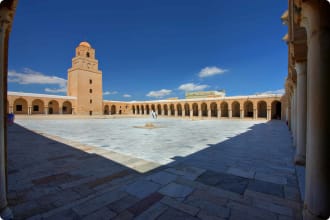

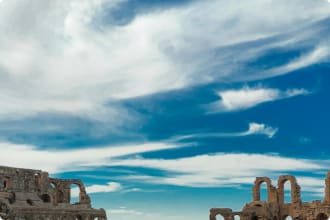
Itinerary
14 days
Day 1: Tunis
Accommodation: Dar El Jeld Hotel & Spa or similar
We make our own way to our accommodation in Tunis, where the group will meet with the Odyssey Program Leader and sit down together for a welcome dinner. (D)
Day 2: Tunis - Carthage - Sidi Bou Said - Tunis
Accommodation: Dar El Jeld Hotel & Spa or similar
Tunis is the capital of Tunisia. Originally a Berber settlement, it fell under Phoenician control in the 9th century BC, ruling from their capital in Carthage. The Carthaginian Empire and the Roman Empire fought each other in the Punic Wars (‘Punic’ has the same root as ‘Phoenician’), which ended with both Carthage and Tunis destroyed and the Romans free to expand into the Mediterranean.
Today we will be visiting Phoenician and Roman ruins in Carthage. Declared a UNESCO World Heritage Site, the town of Carthage has abundant ruins and remains of the Punic and Roman empires: baths, dwellings, mosaics, temples, shrines and the fabulous naval port of the Carthaginians. We will be visiting:
- Tophet archaeological site – a tophet is a sacred site for burial and sacrifice, especially of young children, in the ancient Phoenician religion
- Antonine Baths – the largest built Roman baths on the African continent
- Byrsa Hill – a walled citadel above the Phoenician harbour; according to Virgil, this was where the legendary Tyre princess Dido founded Carthage
- National Museum of Carthage
On our way back to our accommodation in Tunis, we will stop en route at cliff-top Sidi Bou Said in northern Tunisia, a picturesque Andalucian-style village with white-washed buildings and blue doors and windows. Named after a 13th century Sufi saint, the village received protected status in 1915. We will have lunch here at a local restaurant, and explore the beautifully decorated Dar El Annabi House Museum, built in the 18th century. We will also have free time to walk around the village.
(B, L)
Day 3: Tunis
Accommodation: Dar El Jeld Hotel & Spa or similar
Today we will be exploring the main sights of Tunis with a local guide.
The Medina of Tunis, a UNESCO World Heritage Site, was founded in the 7th century, growing around the Zitouna Mosque (Al-Zaytuna Mosque). The great mosque, covering an area of 5,000 square metres, is the oldest in the city, its minaret overlooking the shops and buildings in the medina. It has 160 columns said to have been brought originally from the ruins of Carthage. In the heart of the mosque was a university that had educated many Muslim scholars and political leaders.
We swill stop for lunch at a local restaurant, and in the afternoon visit the Bardo National Museum, home to an extensive collection of Roman mosaics and works that speak to the history of the whole Mediterranean region. The museum has been housed in a 15th-century palace of the Hafsid dynasty since 1888. (B, L)
Day 4: Tunis - Kerkouane - Kelibia - Hammamet - Sousse
Accommodation: Hotel Soussse Palace or similar
We will be travelling from Tunis to Sousse, stopping en route in three ancient and medieval cities across the Cape Bon peninsula.
Kerkouane near the Cape Bon peninsula was a Phoenician city possibly abandoned after the First Punic War and not inhabited nor rebuilt by the Romans. This left behind the ruins of a Phoenician town and necropolis untouched by later civilisations. It is a UNESCO World Heritage Site.
From Kerkouane we continue to Kelibia on Cape Bon to visit the Kelibia Fort. Kelibia, then named Aspis in the 5th century BC, was the site of the first African battle in the Punic Wars. The Kelibia Fort was built in the 16th century.
Our next stop is a visit to the ancient Medina of the port town of Hammamet in Cap Bon’s southeastern coast, before heading to Sousse. We will have dinner in our Sousse accommodation after settling in.
(B, D)
Day 5: Sousse
Accommodation: Hotel Soussse Palace or similar
This morning we will have a guided walking tour of the Medina of Sousse (also spelled Susa or Sousa). This former Phoenician colony fell to the Romans, but largely retained its Arabian look after the Arabian conquest in the 9th century. Its medina, which we will be exploring today, is a UNESCO World Heritage Site. We will also enter the Sousse Archaeological Museum, which is housed in the kasbah or fortification of the medina and covers 2,000 square metres.
The afternoon and remainder of the day is free.
(B)
Day 6: Sousse - Monastir - Moknine - El Jem - Sfax
Accommodation: Hotel Les Oliviers Sfax or similar
Today we will travel to the town of Sfax in the southeast of Tunisia, founded on the ruins of a Roman town. En route, we will stop at the Ribat of Monastir. A ribat is an Islamic defensive structure, and the Ribat of Monastir, founded in 796, was the oldest built by the Arab conquerors in their conquest of North Africa. More towers were added throughout the years, and the structure was refurbished in the 1960s.
We continue to the Habib Bourguiba Mausoleum, located near the main burial site of the city and houses the remains of former president Habib Bourguiba, the father of Tunisian independence, as well as the remains of his family. It is an impressive example of Arab-Muslim architecture, adorned with marble and gold. Within the mausoleum is a small museum with Bourguiba’s personal belongings.
We will learn more about his role in Tunisian independence in the National Movement Museum, which documents Tunisia’s struggle for independence from France.
From Monastir we travel to Moknine, where we will visit local artisans creating ceramics or jewellery.
We transfer to El Jem to visit the El Jem Amphitheatre, the best-preserved Roman amphitheatre in Africa, designed to seat 35,000 spectators.
We continue on to Sfax, where we will have dinner at our accommodation.
(B, D)
Day 7: Sfax - Gabes - Djerba
Accommodation: Dar Dhiafa Djerba Boutique Hotel or similar
We will visit the Dar Jellouli Museum, also known as the Regional Museum of Arts and Folk Traditions, housed in a classical 17th century Tunisian house in the heart of the Sfax medina. It was turned into an artistic centre in 1939 under the direction of French scholar Lucien Golvin.
We will make a stop in the coastal town of Gabes and drive south to the Isle of Djerba, our base for the next three nights. We will have dinner at a local restaurant before settling in for the night. (B, D)
Day 8: Djerba - Ksar Ouled - Chenini - Medinine - Djerba
Accommodation: Dar Dhiafa Djerba Boutique Hotel or similar
Today we will be visiting the Ksar Ouled Soltane in Tataouine, southern Tunisia. A ksar is a fortified Berber-era granary, and the Ksar Ouled Soltane features well-preserved granary vaults built from mud, fortified to protect it from raids. In popular culture, this ksar was also used to represent young Anakin Skywalker’s quarters in Star Wars: Phantom Menace. (The planet in the film was also named Tattooine, after the district.)
We will stop at Douiret and Chenini to view the centuries-old mountaintop Berber villages and troglodyte cave dwellings carved into the hills. We will have lunch in Chenini at a local restaurant.
Before heading back to Djerba, we will stop at the ksar and the honeycomb-like ghorfa (vaulted room) complex in Medinine, a major town in southern Tunisia.
(B, L)
Day 9: Djerba
Accommodation: Dar Dhiafa Djerba Boutique Hotel or similar
We will be spending the whole day exploring the Isle of Djerba. Djerba at 514 square kilometres is the largest island of North Africa, home to Muslim, Berber and Jewish communities. We will visit the island’s main urban centre, Houmt Souk (“market neighbourhood”), which developed from an old Roman site called Gerba. We will enter the Folk Museum (Musée des Arts et Traditions Populaires, Museum of Arts and Popular Traditions) in order to learn more about the culture and folklore of the city and the island.
In the Jewish village of Erriadh, we will visit the El Ghriba Synagogue, the oldest synagogue in Tunisia and a site of pilgrimage, and view the murals of “Djerbahood”, created for a street art event in 2014. We will have lunch at a local restaurant in this village.
Before returning to our accommodation, we will stop at the small town of Guellala, with has a majority Berber-speaking population. It is famous throughout the country for its pottery, an activity that has been supported for centuries by the surrounding rich clay deposits. (B, L)
Day 10: Djerba - Mareth - Tamezret - Matmata - Kairouan
Accommodation: Hotel La Kasbah Kairouan or similar
We will be leaving the Island of Djerba today for Kairouan. On the way we will stop at the Mareth Military Museum, dedicated to World War II and built from the fortification line built by the French to protect Tunisia from Italian invasion.
In Tamezret, we will visit the Berber Museum (Le Musee Berbere de Tamezret), built from the cave of a traditional Berber family home.
In the village of Matmata, we will visit the troglodyte quarters of Hotel Sidi Driss, which will be familiar to fans of the Star Wars saga as the childhood home of Luke Skywalker. We will have lunch at a local restaurant in the area.
In Kairouan, we will have dinner at our accommodation.
(B, L, D)
Day 11: Kairouan
Accommodation: Hotel La Kasbah Kairouan or similar
We will enjoy a full day of sightseeing in Kairouan, a UNESCO World Heritage Site. Kairouan was founded by the Umayyads in the 7th century and became a centre for Sunni Islamic scholarship and an important Islamic city, next only to Mecca and Medina in Saudi Arabia.
We will visit the following
- Aghlabid Basins – an advanced work of engineering in the Middle Ages, built in the 9th century to bring water to this arid region
- Great Mosque of Kairouan – founded in the year 670, and the oldest Islamic place of worship in Africa; nearby is the Lalla Rihana Gate and cemetery with interesting tomb architecture, which we will also view
- Barber’s Mausoleum – built in the 7th century and expanded in the 17th, this houses the tomb of Sidi Sahib, companion of the prophet Muhammad
Following lunch at a local restaurant, we will visit the souks (traditional Arab markets) and see the famous Kairouan carpets and other handicrafts on sale. We will visit the Raqqada National Museum of Islamic Art, located 10 kilometres southwest of Kairouan, which holds collections of medieval Islamic art and objects from Kairouan as well as the sites of Raqqada, the second royal city, and Al-Mansuriya, once the capital of the Fatimid Caliphate. (B, L)
Day 12: Kairouan - Takrouna - El-Fahs - Tunis
Accommodation: Dar El Jeld Hotel & Spa or similar
We will be leaving Kairouan for Tunis today. En route we will stop at the hilltop village of Takrouna. Takrouna is perched approximately 200 metres above sea level, on a hill overlooking the Gulf of Hammamet and Sousse to the east and the Kairouan plain to the south. It also has connections to New Zealand; during World War II, New Zealand forces attacked and eventually captured then Italian- and German-occupied Takrouna.
We will stop for a mint tea at Le Rocher Bleu café, and explore Dar Gmach Museum which is next to the cafe. The museum is housed in a two-room traditional home showcasing Berber artefacts.
En route to El-Fahs, we will stop to view the Zaghouan Aqueduct, an ancient Roman aqueduct that once supplied water to Carthage.
In El-Fahs we will visit the vast Roman site Thuburbo Majus, once a Punic town turned Roman veteran colony around 27 BC, its former wealth evident in the incredible ruins.
From here we will travel to Tunis for the night. (B)
Day 13: Tunis - Jendouba - Dougga - Tunis
Accommodation: Dar El Jeld Hotel & Spa or similar
Today marks our final full day of excursion. From Tunis we head to the archaeological sites of Dougga and Bulla Regia in Jendouba.
Bulla Regia located near Jendouba was a former royal capital of a Numidian kingdom–hence the name, which translates to “Royal Bulla”–and later flourished as a Roman town. The ruins we will see date from this era.
Dougga (or Thugga) likewise was a Roman settlement and is a UNESCO World Heritage Site. In its citation, UNESCO describes it as “the best-preserved example of an Africo-Roman town in North Africa” and “an exceptional illustration of what daily life was like in Antiquity.” It has several temples, baths, residences, and funerary structures, a standout visit for those interested to learn more about Roman presence in the African continent.
We return to our accommodation in Tunis and sit down for our farewell dinner. (B, D)
Day 14: Tunis
Our tour and services end after breakfast. (B)
Includes / Excludes
What’s included in our Tour
- 14 nights of accommodation.
- 14 breakfasts, 3 lunches, and 8 dinners.
- Services of Tour Leader for the duration of tour.
- Transport in comfortable and modern coaches or 4×4 vehicles
- All excursions, entrance fees, and local guides.
- Gratuities and necessary tips.
What’s not included in our Tour
- International airfares and departure taxes.
- Comprehensive travel insurance.
- Items of a personal nature such as telephone calls and laundry.
- Porterage.
Participants must be able to carry their own luggage, climb and descend stairs, be in good health, mobile and able to participate in 3-5 hours of physical activity per day, the equivalent of walking / hiking up to 8 kilometers per day on uneven ground.
Book now
Make it a private tour
Easing your journey
Crossing international borders with restrictions
The list of requirements to travel internationally has changed and will continue to change for several years. Odyssey is here to assist you in managing your way through these requirements:
For more information see our Crossing international borders with restrictions page.
Book With Confidence
If less than 30 days before your tour starts you are unable to travel as a result of Government travel restrictions, Odyssey Traveller will assist you with a date change, provide you with a credit or process a refund for your booking less any non-recoverable costs.
See Terms and conditions for details.
Peace of Mind Travel
The safety of our travellers, tour leader, local guide and support staff has always been our top priority and with the new guidelines for public health and safety for keeping safe for destinations around the world, we’ve developed our plan to give you peace of mind when travelling with us.
See Peace of Mind Travel for details.
Reading List Download PDF
A Tunisian Tale
Hassouna Mosbahi, Max Weiss
After ne'er-do-wells spread rumors about a widowed mother's weak moral character among the people of a slum on the outskirts of Tunis that festers with migrants who have come to the metropolis from the heartland in search of a better life, her twenty-year-old son takes matters into his own hands and commits an unspeakable crime. An imaginative and disturbing novel told from the alternating viewpoints of this unrepentant sociopath, as he sits and fumes on death row but willingly guides us through his juvenile exploits and twisted memories, and his murdered mother, who calmly gives an account of her interrupted life from beyond the grave, A Tunisian Tale introduces the narrative talents of Hassouna Mosbahi to an English-language audience for the first time, as he confronts both taboos of Tunisian society and the boundaries of conventional storytelling.
A History of Modern Tunisia
Kenneth Perkins
Kenneth Perkins' book traces the history of Tunisia from the mid-nineteenth century to the present. After initially examining the years of French colonial rule from 1881 to 1956, when the Tunisians achieved independence, he describes the subsequent process of state-building, including the design of political and economic structures and the promotion of a social and cultural agenda. In conclusion, Perkins reviews the years since 1987, when a new regime came to power. Perkins' informed introduction is a necessity for those who study the region, and also for travellers who want more comprehensive information than most guidebooks offer. Kenneth Perkins is Professor of History at the University of South Carolina. He has worked extensively on North Africa and his research has taken him across the region. His publications include two editions of the Historical Dictionary of Tunisia (Rowman & Littlefield, 1997, 1989), Port Sudan: The Evolution of a Colonial City (Westview Press, 1993), Tunisia: Crossroads of the Islamic and European Worlds (Westview Press, 1986), and Qaids, Captains & Colons: French Military Administration in the Colonial Maghrib, 1844-1934 (Africana Pub, 1981).
Ifriqiya: Thirteen Centuries of Art and Architecture in Tunisia
Jamila Binous, Naceur Baklouti
Ifriqiya: Thirteen Centuries of Art and Architecture in Tunisia is a voyage through the history of the Islamic architecture of the Maghreb, to uncover a millenary civilisation that made works of art of its most important spaces. The great Islamic dynasties - Abbasids, Aghlabids, Fatimids, Zirids, Almohads, Hafsids, Ottomans - and Islamic religious schools and movements left the mark of their artistic expression over the centuries. Islamic art in Tunisia is a cultural crossroad, widely influenced by local artistic customs, by Andalusian and eastern architectural and decorative elements, by Arab, Roman and Berber traditions and by the variety of its natural landscape.
The land of veiled women; some wandering in Algeria, Tunisia and Morocco
John Foster Fraser
Books about Travel in Africa Tourism discus and describe the key features of interest in African countries, the foremost of which is Egypt, with its rish ancient civilization, and adventure and eco-tourism to many other African countries.

